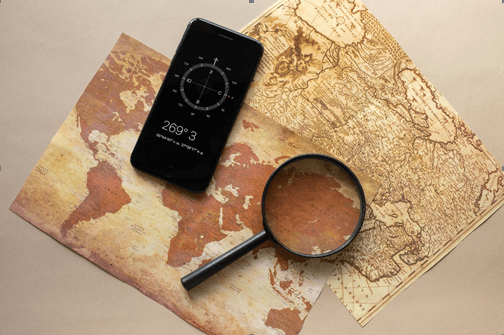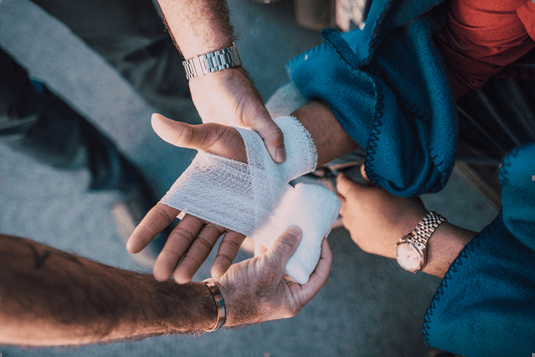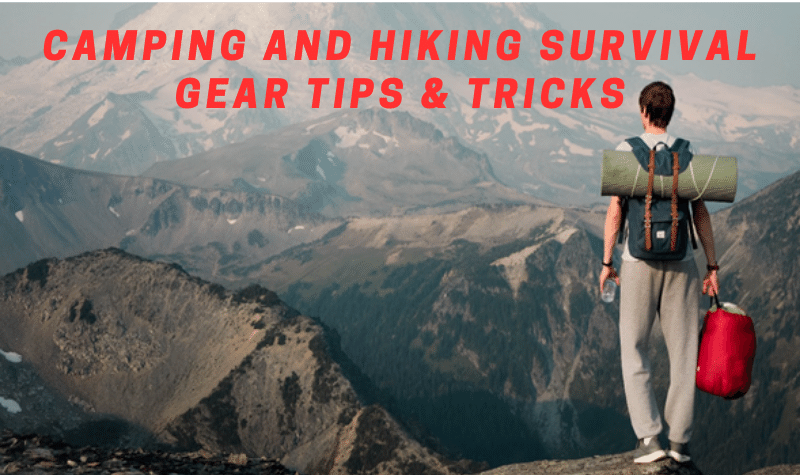The allure of camping and hiking resides in the exhilarating exploration of the vast expanse of the natural world. From awe-inspiring vistas to the liberating sensation of nature’s embrace, these escapades proffer an unparalleled respite from the ceaseless rhythm of everyday existence.
Amidst the thrill, it is imperative to acknowledge the capriciousness of nature. Unforeseen contingencies, such as abrupt weather fluctuations or unforeseen mishaps, can challenge one’s security. Preparedness ceases to be a mere choice; it evolves into an indispensable obligation.
Within this comprehensive article, we delve into the realm of camping and hiking survival gear, furnishing outdoor enthusiasts with the tools to confront any eventuality. From judicious gear selection to fundamental survival proficiencies, we empower adventurers to navigate uncertainties with self-assurance.
Embark upon exploring the elements comprising a well-equipped arsenal, encompassing robust shelters, communication apparatus, first-aid provisions, and beyond. Invariably, safety takes precedence, and with the right equipment and enlightenment, every foray into the outdoors can amalgamate excitement with security.
Keep reading to guarantee that your camping and hiking undertakings are not solely etched in memory but also shrouded in security. Embrace the marvels of the natural world with conviction, standing poised to confront whatever challenges may cross your path.
Camping and Hiking Survival Gear For Safety:
Understanding the Risks

Identifying Potential Emergency Situations:
While the allure of camping and hiking is undeniable, it’s imperative to acknowledge the latent perils inherent in venturing into the untamed wild. Grasping these hazards is the foremost stride toward equipping oneself for manifest exigency.
1. Navigational Perils in the Wilderness
Among the most frequent emergency scenarios within outdoor escapades is finding oneself disoriented in the wilderness. Natural elements may faintly mark or obscure trails, leading wanderers astray. Conditions like fog-induced limited visibility or sudden weather shifts can also contribute to losing bearing.
2. Incidents of Injury during Hikes
Hiking entails navigating uneven terrain, stony paths, and arduous inclines. Mishaps can occur, culminating in injuries such as sprains, fractures, or lacerations. Even minor wounds can snowball into substantial predicaments without proper medical care and provisions.
3. Unpredictable Acts of Nature
Nature’s capriciousness implies that hikers and campers may encounter unforeseen natural calamities, encompassing flash floods, forest fires, or avalanches. These cataclysmic occurrences can expeditiously transform a serene outing into a life-endangering predicament.
Comprehending these plausible emergency scenarios is pivotal to preparing oneself for wild terrains. Acquiring an awareness of these risks empowers adventurers to adopt pre-emptive measures, lessening the probability of mishaps and equipping themselves with requisite survival tools and understanding.
Essential Survival Gear

Navigation Tools:
1. Compass and Map
Essential aids for navigating any expedition in the great outdoors include a dependable compass and a meticulously detailed map. A compass furnishes a sense of orientation, aiding explorers in orienting themselves even amidst unfamiliar landscapes. When coupled with a map, it equips users to strategize routes, pinpoint landmarks, and spot latent hazards.
2. GPS Devices and Smartphone Apps
In conjunction with traditional navigational implements, contemporary adventurers can harness the advantages of geolocation gadgets like GPS devices and mobile applications tailored for outdoor exploits. These instruments proffer real-time location tracing, route blueprinting, and the capacity to download maps for offline usage. Thus, they bestow an augmented stratum of navigational ease and precision.
Communication Devices:
1. Two-Way Radios
Wireless communicators, like two-way radios, expedite effortless information exchange within a hiking or camping cohort, even within regions of constrained cellular connectivity. They afford instantaneous correspondence and can prove priceless during critical junctures, ensuring a unified and informed assembly.
2. Personal Locator Beacons (PLBs)
Individual position indicators (IPIs), exemplified by personal locator beacons (PLBs), manifest as compact, portable contrivances capable of transmitting distress signals to emergency responders when confronted with life-threatening circumstances. When activated, these beacons emit your GPS coordinates, enabling rescuers to ascertain your precise location swiftly.
First Aid Kit:

1. Basic Medical Supplies
A comprehensively supplied initial aid ensemble is imperative to administer medical care in the event of wounds promptly. It must encompass adhesive bandages, gauze pads, sterilizing towelettes, cutting implements, fine-tipped pincers, and adhesive tape.
2. Essential Medicines
In your first aid kit, incorporate vital medications like analgesics, antihistamines, stomach soothers, and any individual prescription medicines mandated by group constituents.
Shelter and Warmth:
1. Quality Tent and Sleeping Bag
A robust and weather-defying tent grants refuge from the elements, affording secure accommodations for the night. Pair it with an appropriate sleeping bag tailored to the projected temperature spectrum, guaranteeing a cozy and tranquil repose.
2. Fire-Starting Tools
Fire-initiating devices like waterproof matches, lighters, or ignition aids are pivotal for generating warmth and preparing sustenance in the great outdoors. Always adhere to fire safety directives and regulations.
3. Emergency Blankets
Compact and featherweight emergency blankets are worth capturing bodily warmth and furnishing supplementary coziness in unforeseen contingencies.
Food and Water:
1. Portable Water Filter or Purifier
Safeguarding access to clean water is pivotal during open-air escapades. Tote a portable water filter or purifier to guarantee an unbroken stream of wholesome potable water from creeks or ponds.
2. Lightweight and High-Calorie Food Items
Include featherweight and nutrient-rich sustenance like energy bars, dehydrated repasts, protein bars, nuts, and desiccated fruits to uphold energy levels during hikes and unanticipated situations.
By outfitting yourself with this indispensable survival paraphernalia, you heighten your preparedness for unforeseen scenarios, assuring a more secure and delightful camping and hiking vacation.
Navigation Techniques:

Understanding Topographical Maps
Topographic charts are invaluable instruments, furnishing comprehensive insights into the topography, encompassing shifts in elevation, water bodies, and other organic attributes. Acquiring the art of deciphering these charts constitutes a pivotal skill for navigating adeptly during outdoor expeditions. Immerse yourself in contour lines, scale, legend, and symbols to aptly unravel the lay of the land.
Utilizing Landmarks and Natural Signs
Landmarks and nature’s signposts emerge as trustworthy beacons while voyaging through untamed terrain. Diligently observe conspicuous features, such as unique rock formations, trees, or mountain summits, as these can aid in pinpointing your position on the map. The mastery of recognizing these telltale signs bolsters your ability to remain on course, thwarting the prospect of wandering astray.
Sun and Star Navigation Tips:
1. Using the Sun
The sun’s trajectory metamorphoses across the day, offering a valuable navigational aid. Within the northern hemisphere, the sun ascends from the eastern horizon and descends beyond the western horizon. Gaze towards the sun during the morning hours to align yourself with the east, while directing your back to the sun during the afternoon signifies the western direction.
2. Using the Stars
During clear nights, the constellations of stars illuminate a path of orientation. The North Star, known as Polaris, remains virtually motionless in the northern sky, offering a beacon for discerning the true north. Decipher additional star patterns and constellations to delineate diverse cardinal points.
By mastering these navigation methodologies, you gain the competence to venture confidently through the natural realm, relying on your acquired prowess to chart your course and return, amplifying the safety and delight of your escapades in camping and hiking.
Protection against Injuries

Preventive Measures:
1. Proper Footwear and Clothing
Selecting appropriate attire and footgear plays a pivotal role in averting mishaps during your camping and hiking endeavors. Acquire robust and cozy hiking boots endowed with ankle reinforcement, curbing the likelihood of ankle contortions or sprains on uneven ground. Opt for moisture-wicking and layered garments that ensure dryness and facilitate body temperature modulation, guarding against hypothermia or heat-induced complications.
2. Stretching and Warm-up Exercises
Before embarking on a hike or partaking in any physically taxing undertaking, engage in stretching routines to preheat your muscles and enhance suppleness. These preliminary exercises amplify blood circulation to the muscles, mitigating the vulnerability to strains and other injuries throughout your expedition.
Treating Common Injuries:
1. Cuts, Scrapes, and Blisters
Equip yourself with a compact first aid kit housing adhesive bandages, antiseptic wipes, and blister cushions. Swiftly cleanse any minor abrasions or cuts to avert contamination and cloak them with sterile coverings. For blisters, employ blister cushions or moleskin to shield the affected region from further vexation.
2. Sprains and Strains
In a sprain or strain, the RICE approach can provide initial respite: Rest, Ice, Compression, and Elevation. Abstain from bearing weight on the injured area, employ ice to curtail inflammation, utilize a compressive bandage to bolster the joint and elevate the extremity to diminish swelling.
3. Insect Bites and Stings
Defend against insect bites and stings by employing insect repellents and donning garments with long sleeves and pants. If a bite or sting occurs, cleanse the zone with soap and water, apply an ice pack to alleviate swelling, and utilize antihistamine ointments or oral medications for itch alleviation.
Equipping yourself to avert and cope with injuries guarantees a more secure and pleasurable camping and hiking escapade, enabling you to wholly relish the splendor of nature devoid of unwarranted hazards.
Staying Safe in Natural Disasters

Lightning Storms and Thunderstorms:
1. Safe Shelter Options
In the presence of lightning storms or thunderstorms, promptly locate a secure shelter. Steers clear of exposed spaces, tall solitary objects, and water bodies. Seek out entirely enclosed structures such as towers or automobiles to shield yourself from lightning discharges.
2. Lightning Safety Tips
Stay indoors until the storm abates, and refrain from utilizing electrical appliances or plumbing during the storm. If stranded outdoors without refuge, assume a low crouch on the balls of your feet, maintaining a low profile without lying down. Curtail contact with the ground to lessen the possibility of electrical currents.
Flash Floods and River Crossings:
1. Understanding Local Weather Conditions
Before commencing a hike or camping expedition, examine the regional weather prognosis and stay mindful of potential hazards linked to flash floods. Intense downpours nearby can swiftly induce flash floods, rendering river crossings dangerous.
2. Techniques for Safe River Crossings
Evade river crossings during torrential rain or when water levels are elevated and rapid. If compelled to cross, search for serene, shallow areas and employ trekking poles or sticks for augmented steadiness. Loosen your backpack’s buckles to facilitate swift detachment in an unforeseen crisis.
Wildfires and How to Respond:
Stay well-informed regarding the potential threat of wildfires in the vicinity you intend to camp or hike. If you encounter a wildfire, promptly vacate the vicinity by adhering to established evacuation pathways. In circumstances where departure proves unfeasible, seek out an open space far from combustible substances, assume a prone position, and shield yourself using attire or a damp covering to counteract the effects of radiant heat.
Gaining insights into and readying for natural calamities can notably enhance your security during camping and hiking vacations. Grasping the perils and mastering appropriate responses can be pivotal in preserving lives and sidestepping mishaps amidst the wild terrain.
Personal Safety in the Wilderness

Wild Animal Encounters:
1. How to Act in the Presence of Various Wildlife
Maintaining composure and refraining from sudden actions becomes paramount when you come face to face with wildlife amid the wild expanse. Refrain from approaching or attempting to nourish any wild creatures. Instead, create ample distance and observe from a position of safety. Honor their natural habitat and conduct.
2. Bear and Cougar Safety
In instances of bear encounters, expand your presence by raising your arms and emitting loud sounds to unnerve them and induce retreat. Dodge direct eye contact and slowly retreat. Should you encounter a cougar, retain eye contact and project a substantial figure. Converse with conviction and resonance while gradually retreating.
Self-defense Strategies:
1. Carrying Personal Safety Tools
Bringing personal safety equipment can furnish an extra layer of safeguarding in the untamed outdoors. Whistles can serve as a means to alert others to your whereabouts in times of urgency, while the bear spray is an effective deterrent against assertive wildlife.
2. Avoiding Confrontation and De-escalation
The optimal strategy in the wild is evading confrontations when feasible. Adhere to designated trails and steer clear of areas with recent signs of wildlife activity. Should you encounter fellow trekkers or campers, extend respect, and grant them personal space. If a situation appears to escalate, strive to de-escalate it through-composed dialogue and gradual retreat.
By understanding the protocol during interactions with wild creatures and carrying appropriate safety gear, you heighten your safety during ventures of camping and hiking. Demonstrating reverence for wildlife and exercising self-defensive tactics contribute to a wilderness journey that is more secure and profoundly gratifying.
Mental Preparedness:
Staying Calm in Emergencies
In any instance of urgency, upholding a composed and collected mind is paramount. The turbulence of panic can obscure discernment and hinder the capacity to make sound judgments. Engage in deep breathing exercises and mindfulness practices to retain concentration and assertiveness. Remind yourself that preserving tranquility heightens the likelihood of devising solutions and taking prudent actions.
Building Resilience and a Positive Mindset
Cultivating mental resilience proves pivotal in surmounting challenges presented by the wilderness. Embrace an optimistic outlook, understanding that you’ve readied and equipped yourself to confront unforeseen circumstances. Direct your focus towards innovative problem-solving and adaptability. You can approach adversities with certainty and unwavering resolve by nurturing mental fortitude.
The Power of Preparation and Planning
The profound impact of meticulous preparation cannot be understated. Meticulous pre-planning before setting out on any camping or hiking expedition bolsters mental readiness. Acquaint yourself with the topography, atmospheric conditions, and potential hazards of the locale. Construct a comprehensive schedule and share it with a dependable individual who can help in times of crisis. The knowledge of having devised strategies for diverse scenarios imparts a sense of command and diminishes apprehension.
In the realm of the wild, mental readiness parallels physical preparedness. By upholding serenity, fostering resilience, and focusing on meticulous preparation, you heighten your aptitude to confront and effectively manage difficult circumstances. An optimistic and well-prepared mentality will substantially enrich outdoor escapades, making them safer and more gratifying.
Emergency Protocols and Communication:

Creating an Emergency Plan Before the Trip
Before embarking on any outdoor expedition, it’s imperative to devise a thorough contingency strategy. This strategy should encompass potential perils and hazards unique to the area of exploration. Identify secure rendezvous points, emergency egress routes, and proximate refuges. Assign distinct roles to each group member, ensuring a clear delineation of responsibilities in the event of a necessity. A meticulously conceived strategy guarantees unanimity of action and rapid response if difficulties arise.
Informing Friends or Family about the Itinerary
It’s prudent to consistently brief acquaintances or family about your travel blueprint, encompassing the location, planned course, and estimated return interval. Furnish them with contact details for local emergency services. Routinely apprise your designated liaisons of any alterations in your agenda. This communication is paramount, empowering them to initiate alerts if your homecoming is not punctual.
Knowing When and How to Signal for Help
In emergencies, mastering the art of signaling for assistance is paramount. Equip yourself with signaling implements, such as whistles, signal mirrors, or vividly hued attire that can draw attention. Three resounding and unmistakable whistle sounds are universally recognized as a distress call. If feasible, identify an unobstructed locale with favorable visibility to augment the likelihood of detection by rescuers. Furthermore, familiarize yourself with varied emergency communication methodologies, such as employing flares or smoke signals.
By constructing a meticulously crafted emergency stratagem, apprising trustworthy connections of your itinerary, and comprehending the nuances of effective distress signaling, you heighten the probability of a triumphant rescue during critical junctures. Preparedness and establishment of efficient communication protocols can be instrumental in safeguarding lives during unforeseen wilderness emergencies.
Additional Resources
If you are looking for more tutorials, walkthroughs and troubleshooting about camping and enjoying the outdoors, here are some additional posts to check out:
Conclusion
Embarking on exhilarating escapades into the realm of camping and hiking necessitates an unwavering focus on safety and readiness. The magnetic pull of the untamed wilderness should always be harmonized with a profound sense of duty to safeguard ourselves and our fellow adventurers throughout our odysseys.
Equipping ourselves with indispensable survival paraphernalia stands as an imperative. Ranging from instruments of navigation to comprehensive first aid kits, each article assumes a pivotal role in safeguarding our welfare amid the capricious outdoor realm.
Whether we’re experienced adventurers or just starting out, it’s important to always think ahead. Make careful plans, be aware of potential dangers, and go forward with a mix of confidence and mindfulness.
In the wild, having the right mindset is as important as having the right gear. Stay calm, build your mental strength, and face challenges with a positive attitude. This way, you can overcome unexpected obstacles with skill.
Let’s fully enjoy the beauty of nature while being responsible. When we go camping and hiking, we should use the right equipment and always prioritize safety. This way, we can have exciting adventures while also keeping ourselves safe. If you have a story or some advice to share, feel free to leave your comment below. Be Safe and I wish you a great time on your next outdoor adventures!

